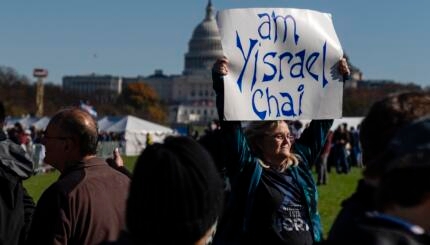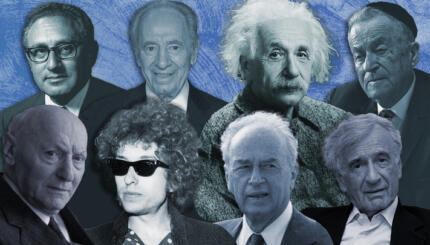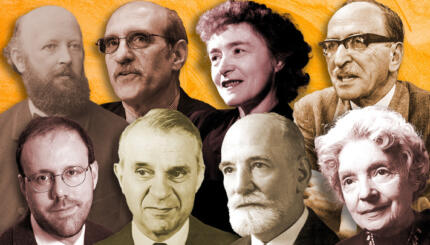The link between Jewish poets and America is grounded in the very foundation of the country’s symbols of freedom and tolerance. Inscribed on the Statue of Liberty are these famous lines by the Jewish poet Emma Lazarus (1849-1887), from her poem “The New Colossus”: “Give me your tired, your poor,/Your huddled masses yearning to breathe free,/The wretched refuse of your teeming shore.” The Russian pogroms of 1881 would inspire Lazarus to write more of her Jewish experience in Songs of a Semite. The poems were a call to arms for Jews around the world, evoking the heroic past of Jewish history: “Wake, Israel, wake!/ Recall to-day/The glorious Maccabean rage,/The sire heroic, hoary-gray,/His five-fold lion-lineage.”
Lazarus was one of the first American Jewish poets whose work was explicitly Jewish and American, but it was not until the post-World War II era that there was a sustained burst of American poetry  informed by Jewish experience. Delmore Schwartz (1913-1966), who eventually found more lasting fame as a short-story writer (In Dreams Begin Responsibilities), turned Walt Whitman’s odes to the glories of the country into an immigrant’s song in “America, America!” (1954): “I am a poet of the Hudson River and the heights above it,/the lights, the stars, and the bridges/I am also by self-appointment the laureate of the Atlantic/-of the people’s hearts, crossing it/ to new America.”
informed by Jewish experience. Delmore Schwartz (1913-1966), who eventually found more lasting fame as a short-story writer (In Dreams Begin Responsibilities), turned Walt Whitman’s odes to the glories of the country into an immigrant’s song in “America, America!” (1954): “I am a poet of the Hudson River and the heights above it,/the lights, the stars, and the bridges/I am also by self-appointment the laureate of the Atlantic/-of the people’s hearts, crossing it/ to new America.”
Schwartz had filtered Whitman’s lyrical tone and glorified mundaneness into his own voice. In a similar fashion Allen Ginsberg (1926-1997) became one of the most beloved Jewish American poets, applying his ecstatic joy and devoted attention to the infinite variety of American experience through political critique, ballads to homosexual desire, and a canny use of Biblical and religious imagery. Ginsberg made Jewishness a condition of his work—another aspect of his self that could no longer be rejected in the name of the American melting pot. In perhaps his most famous poem, “Howl,” Ginsberg turns a false god of the Old Testament into the false gods of postwar America. “Moloch whose skyscrapers stand in the long streets like endless Jehovahs! Moloch whose factories dream and croak in the fog! Moloch whose feet and antennae crown the cities!” His other lasting classic, “ ,” is a moving tribute to his mother, rendered as a lament and inspired by the Jewish prayer for the dead. “I’ve been up all night, talking, talking, reading the Kaddish aloud….” Ginsberg says in the poem, “And read Adonais’ last triumphant stanzas aloud—wept, realizing/ how we suffer–/And how Death is that remedy all singers dream of, sing, remember,/prophesy as in the Hebrew Anthem.”
The latter half of the 20th century saw a new strain of Jewish poet, one less inclined to outward exploration of Jewish identity or faith. Former Poet Laureate Stanley Kunitz (1905-2006) looked to John Donne and 19th century British Romanticism for inspiration. Howard Nemerov (1920-1991) turned to writers and thinkers strongly influenced by Christianity, such as Dante and St. Augustine. Louise Gluck’s (1943- ) poetry tends toward classical resonances, with titles like “The Triumph of Achilles” and “Odysseus’ Decision.” Robert Pinsky (1940- ) translated Dante and Czeslaw Milosz, and penned tributes to television and baseball (while, admittedly, singling out Sandy Koufax in “The Night Game” for not pitching on Yom Kippur).

Help us keep Jewish knowledge accessible to millions of people around the world.
Your donation to My Jewish Learning fuels endless journeys of Jewish discovery. With your help, My Jewish Learning can continue to provide nonstop opportunities for learning, connection and growth.
For the most part, these poets were not inclined to pay explicit tribute to their religious background. And yet, something lingered in their work, often in conjunction with a pan-religious, secular humanism that used Judaism as a stepping-stone to other cultures. “Writers are all secret Jews,” Pulitzer Prize-winning poet Maxine Kumin (1925- ) declared in a 1975 interview, and while the levels of secrecy wavered, the Jewish content was still there. Offering a “Tattered Kaddish” after Ginsberg’s, Adrienne Rich’s (1929- ) burstingly lyrical, politically charged feminist poems were also often Jewish in nature, combining her own heritage with a wide variety of American experience. “Living Memory,” from 1988, took a Jewish prayer, conflated it with a Catholic ceremony, and made it an overpowering ode to life: “A yahrzeit candle belongs/to life. The sugar skulls/eaten on graves for the Day of the Dead/belong to life. To the living. The Kaddish is to the living,/the Day of the Dead, for the living.”
Judaism, and Jewish culture, has become a backdrop and historical reference point for the latest generation of American Jewish poets, inspired both by its spiritual seeking and its cultural history. Samuel Menashe, born in 1925 but only discovered by a wide audience after he turned 80, learned Yiddish as a first language and titled his first book No Jerusalem But This. Menashe’s work gestures toward a spiritual search that is quasi-Jewish in nature, seeking meaning in nature above all. Contemporary poet Alicia Ostriker (1937- ) similarly invests her secular world with a Jewish bent, picturing “Armies of aging Jews soaking up sun/as if it were Talmud” in “Beck and Benny in Far Rockaway,” and penning a tribute to Ginsberg as “The greatest Jewish poet/After Celan and Amichai” in “Elegy for Allen.”
In 2011, Philip Levine (1928- ) was named U.S. poet laureate, succeeding, among others, the Jewish poets Robert Pinsky, Louise Gluck, and Howard Nemerov. Levine’s parents were Russian Jewish immigrants and he grew up in World War II-era Detroit, during the time of Father Coughlin and his anti-Semitic radio broadcasts. Levine’s poems are devoted to manual labor and the working class, with titles like “I Sing the Body Electric.” “Is it long as a noodle/or fat as an egg?,” Levine wonders in “The Whole Soul.” “Is it/lumpy like a potato or/ringed like an oak or an/onion and like the onion/the same as you go toward/the core?”
From the huddled masses to the ringed onion, American Jewish poets have reflected the wit, scope, and spiritual depth of the American poetic impulse. The religiously charged specifics—-the yahrtzeit candles and prayers for the dead and Talmuds–blend into a larger portrait of the infinitely variable America. The poets stand out, emblems of the uniqueness of the American Jewish experience.


